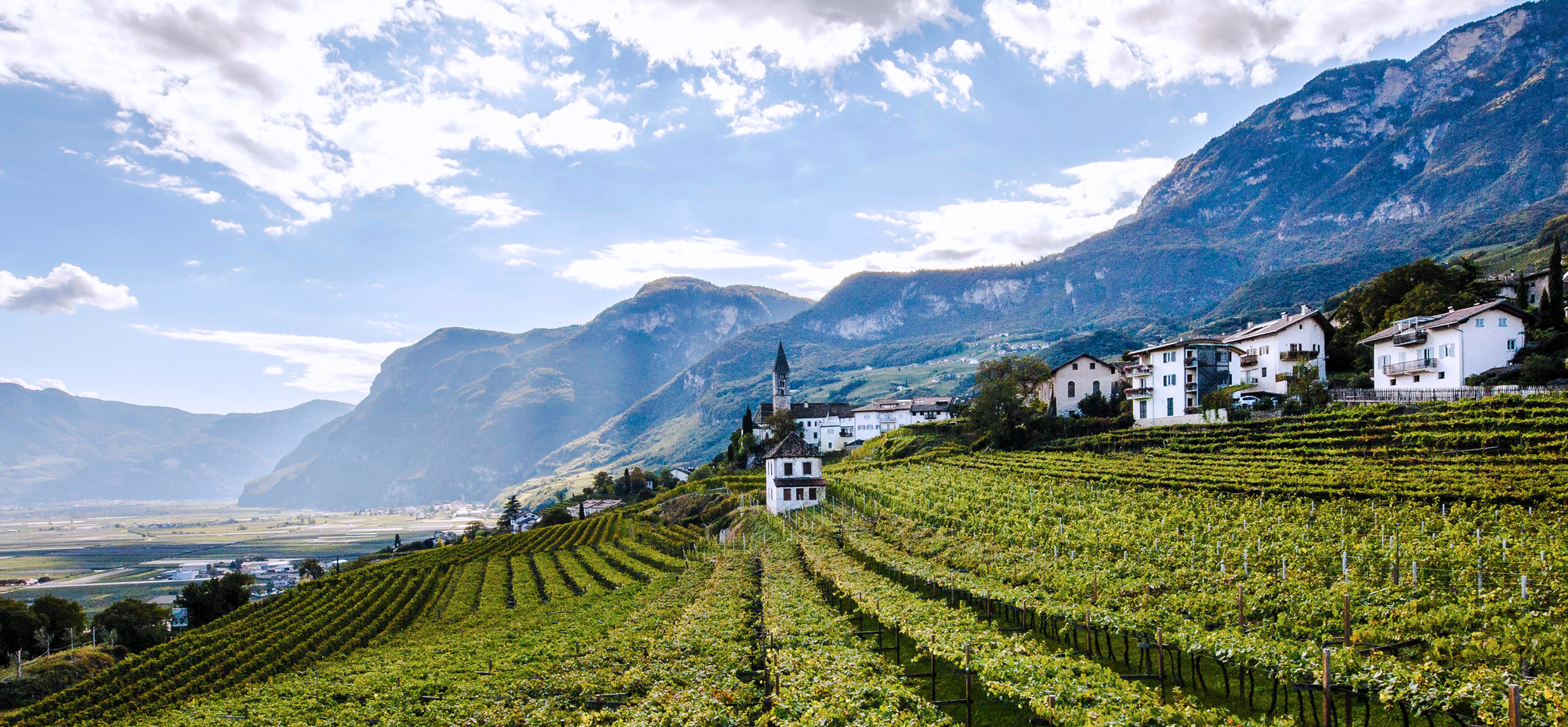Located in Northeastern Italy, Alto Adige is an alpine region that beguiles with its beauty. Occupying a Y-shaped glacial valley tucked within the Dolomites Mountains, it is a prime source of Italy’s greatest mountain wines.
When most people think of vineyards, they envision the rolling hills of Tuscany, or the rugged ones of Sicily. They think of the flat valleys of the Piedmont and the foothills of the Apennines, rising from the eastern coast in Puglia and the western coast of Campania, yet there is another class of wine that grows at high elevation on rocky mountain slopes in the north.
For those that have ever taken a gondola up a mountain, you could not fail to notice how the air cools, while the sunshine intensifies. Grapes that are grown on the mountain slopes experience the same effects, though with different results. The cooler air, especially at night, imbues the grapes with an almost electric character, waiting to release its stored energy, while unfiltered sunlight develops the sugars and flavors inside the grapes. Alto Adige enjoys 300 days of sunshine and wide day-to-night temperature swings known as a diurnal shift. Thus, mountain winemakers enjoy the best of both worlds – mouthwatering acidity and ripe fruit flavors.
Within a postcard setting, where snow-capped craggy peaks rise from the earth, you will find vineyards growing between at altitudes of over 3,000 feet above sea level. Soils at that height do not contain the typical sandy, loamy, silty soil that you would expect to find in most vineyards. The hearty vines grow in a nutrient-poor composition of rock, glacial moraine and volcanic remnants from eons ago, but because the vines struggle, they produce more complex wines.
It is a land of harmonious contrasts, where Italian food meets the cultural influences of its northern neighbors and where the Mediterranean sun warms Alpine vineyards. From indigenous grapes to international varieties; from small family vineyards to successful cooperatives, traditional techniques and modern facilities produce outstanding wines, set amid a region of dramatic beauty.
Italy has long been known for its indigenous grapes with hundreds of unusual and sometimes little-known varieties that are found solely and uniquely within the country. However, certain regions provide an environment where popular international varieties thrive, as well and Alto Adige, in the northeast portion of the country is one such place. Growing alongside local grapes such as Lagrein and Schiava, are Pinot Grigio, Pinot Bianco, Chardonnay, Sauvignon Blanc and Pinot Nero.
Of the so-called international grapes, Pinot Grigio is Alto Adige’s largest by volume. The grape grows widely across neighboring regions, but perhaps none as well as in Alto Adige, where the days of sunshine and cool alpine nights impart a zesty ripe and citrusy character to the wine.
The other white Pinot – Bianco, has become the wine to watch. Reductions in yields, changes in vineyard training systems and higher elevation plantings on hillsides have improved quality, especially around the town of Appiano (just southwest of Bolzano). The wine is Grigio’s soft-spoken counterpart, with a rounder mouthfeel that evokes honey, melon and flowers.
Alto Adige also produces a Chardonnays that is best described as possessing finesse. This is no small feat for the world’s most popular white grape. Chardonnay grapes in the region saw a proliferation of plantings three decades ago. The vines are now mature enough to show off a delicate side, producing medium-bodied wines with nuanced layers of citrus and minerality.
Sauvignon Blanc, important globally, grows in small quantities in Alto Adige. The variety excels because the vineyards are farmed in small plots. Sauvignon Blanc turns dull when produced in quantity over quality. Smaller yields and hands-on techniques ensure the variety’s complexity and balance are preserved.
In the pantheon of red grapes, it is easy to see why Pinot Nero (Noir) thrives. The best versions of this noble variety feature fresh red berry fruits and taut acidity for backbone and longevity. Alto Adige’s wide day to night temperature range lends Pinot Noir this trait in spades, but as outstanding as Nero may be, it takes a back seat to two other grapes in the region.
Schiava is a light-bodied red that has long been the locals’ wine of choice. The grape comprises a large percentage of Alto Adige’s vineyard plantings. Much of the wine is consumed without leaving the region, but the best producers have taken to exporting their wines. In body, hue and flavor, Schiava is comparable to Pinot Noir. It is a great wine for food pairing, offering berry fruit flavors like strawberry and cherry, with notes of rose petal on a dry palate. With lower alcohols, often hovering around 12-13%, Schiava is a perfect daytime wine, especially with a slight chill for a summer picnic.
Arguably, the finest grape from the region is the Lagrein. Only on rare occasions will one come across the Lagrein within the vineyards of America. The grape has its origins in Alto Adige, in the Province of Trento and is a descendant of the Teroldego variety. Cultivation of Lagrein has traditionally resulted in complex, tannic red wines such as Lagrein Scuro, as well as fragrant rosé wines including Lagrein Rosato. In recent years, winemaking techniques have changed, with shortened maceration periods and oak casks to achieve a less aggressive tannin that still maintains exceptional character. The greatest examples have proven themselves on the world stage, with top scores from critics and increased media attention. Perhaps the finest example of this wine is the Cantina Tramin Lagrein (imported into the U.S. by Winebow). Bright ruby red in color, this Lagrein offers intense and complex aromas of cocoa, cinnamon, wild berries and violets. Harmonious on the palate, with fine structured tannins, it is full-bodied and velvety, with notable complexity. Our recommendation is when you find a bottle of Cantina Tramin Lagrein at your wine shop – make sure to pick up a few bottles. Once you have tried it, you will be back to purchase a case of the magnificent wine.




